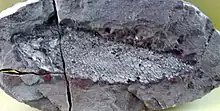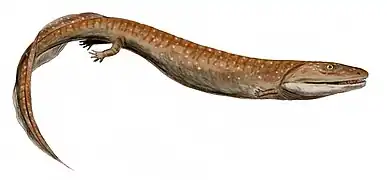| Osteolepis Temporal range: | |
|---|---|
 | |
| Osteolepis macrolepidotus fossil at the Museum für Naturkunde, Berlin | |
| Scientific classification | |
| Domain: | Eukaryota |
| Kingdom: | Animalia |
| Phylum: | Chordata |
| Clade: | Sarcopterygii |
| Clade: | Tetrapodomorpha |
| Order: | †Osteolepiformes |
| Family: | †Osteolepididae |
| Genus: | †Osteolepis Agassiz, 1843 |
Osteolepis (from Greek: ὀστέον ostéon 'bone' and Greek: λεπίς lepis 'scale')[1] is an extinct genus of lobe-finned fish from the Devonian period. It lived in the Lake Orcadie of northern Scotland.
Osteolepis was about 20 centimetres (7.9 in) long, and covered with large, square scales. The scales and plates on its head were covered in a thin layer of spongy, bony material called cosmine. This layer contained canals that were connected to sensory cells deeper in the skin. These canals ended in pores on the surface and were probably for sensing vibrations in the water.[2]
Osteolepis was a rhipidistian, having a number of features in common with the tetrapods (land-dwelling vertebrates and their descendants), and was probably close to the base of the tetrapod family tree.

References
- ↑ Roberts, George (1839). An etymological and explanatory dictionary of the terms and language of geology. London: Longman, Orme, Brown, Green, & Longmans. p. 127. Retrieved 31 December 2021.
- ↑ Palmer, D., ed. (1999). The Marshall Illustrated Encyclopedia of Dinosaurs and Prehistoric Animals. London: Marshall Editions. p. 43. ISBN 1-84028-152-9.
.jpg.webp)




